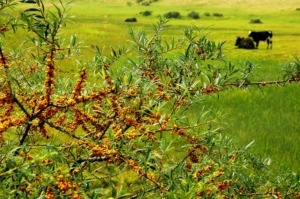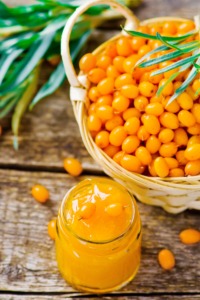Ripe sea buckthorn berries are yellow, orange, or red. The general composition of a sea buckthorn berry is 68% pulp, 23% seed, and 7.75% skin. Sea buckthorn berries tastes unpleasant due to their high acidity and astringency.
Depending on the climate, subspecies, origin, harvest time, and methods of processing, the nutritional composition of sea buckthorn berries can vary. Various kinds of bioactive substances are found in sea buckthorn fruit oil and seed oil. Sea buckthorn fruits are one of the most vitamin-rich fruits produced by any plant. Sea buckthorn berries are rich in flavonoids and other antioxidants, vitamins, phytosterols, polyunsaturated fatty acids (especially palmitoleic acid omega-7 ), amino acids, and minerals. There are large amounts of lipids in sea buckthorn berries. Lipids boost the bioavailability of carotenoids, improving their absorption in humans.
Vitamins
The most characteristic feature of sea buckthorn fruits is their high content of vitamin C. The amount of vitamin C is 2500 mg/100 g in berries from the Chinese subspecies Hippophae rhamnoides Linn. The differences between the levels of vitamin C in sea buckthorn berries from different regions are related to the local environmental conditions.
Other vitamins found in sea buckthorn fruit include vitamin E. The amount of vitamin E in the berries is 160 mg/100 g, the value is 162–255 mg/100 g in the juice, 481 mg/100 g in the pulp, and 40.1–103.0 mg/100 g in the seeds. Vitamin K is crucial for the post-synthesis modification of proteins that partake in blood coagulation, can control calcium binding in bones and other tissues.
Phytosterols
Tthe content of total sterols in sea buckthorn (Hippophae rhamnoides Linn.) ranges from 240–400 mg/kg in the pulp, 340–520 mg/kg in the whole berries and 1200–1800 mg/kg in the seeds. Derivatives of sitosterol were found in the sea buckthorn. The other major sterols include campesterol, stigmastanol and r-amyrin. The consumption of plant sterols can reduce plasma cholesterols in humans, which is important to treat coronary heart disease.
Amino Acids
Sea buckthorn berries contain 18 of the 22 known amino acids. Amino acids help building blocks of proteins. participating in crucial processes in the human body, such as energy production, building cells and fat loss. Essential amino acids include threonine, valine, methionine, leucine, isoleucine lysine, tryptophan and phenylalanine.
Organic Acids
The main organic acids found in sea buckthorn fruits are malic and quinic acids. Together, these acids constitute around 90% of all fruit acids in sea buckthorn plants. Chinese sea buckthorn(Hippophae rhamnoides Linn.) show the highest concentrations of organic acids (3.5–9.1 g/100ml).
Mineral Elements
The mineral elements found in sea buckthorn fruit include iron, magnesium, copper, zinc, sodium, potassium, phosphorus, calcium,  nitrogen, and manganese. The most abundant mineral element in sea buckthorn is potassium, at concentration of 10.12–14.84 ppm in the pulp and 9.33–13.42 ppm in the seed.
nitrogen, and manganese. The most abundant mineral element in sea buckthorn is potassium, at concentration of 10.12–14.84 ppm in the pulp and 9.33–13.42 ppm in the seed.
Sugars
Glucose, fructose, and xylose are the three main sugars found in sea buckthorn berries. Total soluble sugars in Chinese sea buckthorn(Hippophae rhamnoides Linn.) constitute between 5.6% and 22.7% of raw juice. Berries originating from China contained the highest levels of sugars, followed in decreasing order by berries from Russia and Finland.
The main sugar in sea buckthorn berries of all origins is glucose. Together with fructose, glucose accounts for around 90% of the total sugar content in berries in China and Russia. Finnish species are characterized by lower amounts of these sugars (60%).
Volatile Compounds
Sea buckthorn berries possess a unique aroma, due to their content of volatile compounds. These volatile substances are mainly short chain esters, branched or n-fatty acids, and alcohols. The time of harvest determines the composition of volatiles. Hippophae rhamnoides Linn. berries contain large amounts of ethyl 3-methylbutanoate, butyl pentanoate, 2-methylpropyl 3-methylbutanoate, and pentyl 3-methylbutanoate.

Leave A Comment